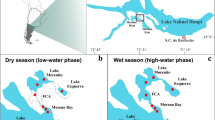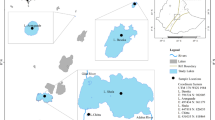Abstract
Variations of the trophic status of lakes Batorino, Myastro, and Naroch were analyzed over a long period of 1978–2013. The lakes form a system of interconnected water bodies with a wide range of trophic states. In the period under consideration, the trophic conditions in the lakes varied from highly eutrophic (Lake Batorino) to oligotrophic (Lake Naroch), making it possible to analyze the long-term changes in the trophic state of the lakes with the use of different variants of evaluating the Carlson index (trophic state index, TSI), to assess the relationship between the three versions of the index with one another, with phytoplankton biomass, and with hydroecological characteristics, such as the concentrations of total N, seston, and organic matter and biochemical oxygen demand. The possibility to evaluate the index by other characteristics, including phytoplankton biomass, was also considered.
Similar content being viewed by others
References
Aronov, A.G., Aronova, T.I., Vlasov, B.P., et al., Vodnye resursy Natsional’nogo parka “Narochanskii” (Water Resources of the Narochanskii National Park), Minsk: Riftur Print, 2012.
Metody issledovaniya organicheskogo veshchestva v okeane (Methods for Studying Organic Matter in the Ocean), Moscow: Nauka, 1980.
Mikheeva, T.M., Al’goflora Belarusi. Taksonomicheskii katalog (Belarus Algoflora: Taxonomic Catalog), Minsk: Izd. BGU, 1999.
Mikheeva, T.M., Methods for nanophytoplankton counting: a review, Gidrobiol. Zh., 1989, vol. 25, no. 4, pp. 3–21.
Mikheeva, T.M. and Luk’yanova, E.V., Comparative assessment of phytoplankton abundance in the littoral and pelagic zones of Lake Naroch at different stages of its trophic status evolution, in Strategiya razvitiya akvakul’tury v usloviyakh XXI veka. Materialy mezhdunar. nauch.-prakt. konf. (Development Strategy of Aquaculture under the Conditions of the XXI Century. Mater. Intern. Sci.-Pract. Conf.), Minsk: Tonpik, 2004, pp. 224–228.
Mikheeva, T.M. and Luk’yanova, E.V., Comparative assessment of phytoplankton abundance in the littoral and pelagic zones of Lake Myastro at different stages of its trophic status evolution and some features of the structural organization of littoral plankton in the Narochanskie Lakes in de-eutrophication period, Vopr. Rybn. Khoz. Belar., 2008, no. 24, pp. 315–318.
Ostapenya, A.P., Zhukova, T.V., Mikheeva, T.M., et al., Bentification of a lake ecosystem: causes, mechanisms, possible consequences, perspectives of studies, Tr. BGU, 2012, vol. 7, Part 1, pp. 135–148.
Rukovodstvo po khimicheskomu analizu poverkhnostnykh vod sushi (Guide on the Chemical Analysis of Continental Surface Waters), Leningrad: Gidrometeoizdat, 1977.
Sigareva, L.E., Spectrophotometric method for determining phytoplankton pigments in a mixed extract, in Metodicheskie voprosy izucheniya pervichnoi produktsii planktona vnutrennikh vodoemov (Methodological Issues of Studying Plankton Production in Inland Water Bodies), St. Petersburg: Gidrometeoizdat, 1993, pp. 75–85.
Sidelev, S.I. and Babanazarova, O.V., Anslysis of relationships between pigment and structural characteristics of phytoplankton in a highly eutrophic lake, Zhurn. Sibirskogo Feder. Univ., 2008, vol. 2, no. 1, pp. 162–177.
Unifitsirovannye metody analiza vod (Unified Methods for Water Analysis), Moscow: Khimiya, 1973.
Akkoyunlu, A. and Ileri, R., Evaluation of eutrophication process in Lake Sapanca, Proc. Kayseri 1st Wastewater Sympos. Kayseri: Kayseri Metropolitan Municipality, 1998, pp. 357–361.
Baban, S.M.J., Trophic classification and ecosystem checking of lakes using remotely sensed information, Hydrol. Sci. J., 1996, vol. 41, no. 6, pp. 939–957.
Boavida, M.J. and Marques, R.T., Total phosphorus as an indicator of trophic state of Portuguese reservoirs, Limnetica, 1996, vol. 12, no. 2, pp. 31–37.
Carlson, R.E., A trophic state index for lakes, Limnol. Oceanog., 1977, vol. 11, pp. 361–369.
Dillon, P.J. and Rigler, F.H., The phosphorus chlorophyll relationship in lakes, Limnol. Oceanogr., 1974, vol. 19, no. 5, pp. 767–773.
Forsberg, C., Die physiologischen grundlagen der gewasser-eutrophierung, Z. Wasser and Abwasser Forsch, 1979, vol. 12, no. 2, pp. 40–45.
Fruh, E.G., Stewart, K.M., Lee, G.F., and Rohlich, G.A., Measurements of eutrophication and trends, J. Water. Poll. Contr. Fed., 1966, vol. 38, pp. 1237–1258.
Havens, K.E., Secondary nitrogen limitation in a subtropical lake impacted by non-point source agricultural pollution, Environ. Pollut., 1995, vol. 89, pp. 241–246.
Hillebrand, H., Durselen, C.-D., Kirschtel, D., et al., Biovolume calculation for pelagic and benthic microalgae, J. Phycol, 1999, vol. 35, pp. 403–424.
Hong, H.C., Wong, M.H., Mazumder, A., and Liang, Y., Trophic state, natural organic matter content, and disinfection by-product formation potential of six drinking water reservoirs in the Pearl River delta, China, J. Hydrol., 2008, vol. 359, pp. 164–173.
Jarosiewicz, A., Ficek, D., and Zapadka, T., Eutrophication parameters and Carlson-type trophic state indices in selected Pomeranian lakes, Limnol. Rev., 2011, vol. 11, no. 1, pp. 15–23.
Kratzer, C.R. and Brezonik, P.L., A Carlson-type trophic state index for nitrogen in Florida lakes, Water Res. Bul., 1981, vol. 17, pp. 713–715.
Lillesand, T.M., Johnson, W.L., Denell, R.L., et al., Use of Landsat data to predict the trophic state of Minnesota lakes, Photogram. Eng. Remote Sens., 1983, vol. 49, pp. 219–229.
Matthews, R., Hilles, M., and Pelletier, G., Determining trophic state in Lake Whatcom, Washington (USA), a soft water lake exhibiting seasonal nitrogen limitation, Hydrobiologia, 2002, vol. 468. pp. 101–121.
Mayhew, E. and Mayhew, M., The trophic status of Lake Sidney Lanier, Proc. Georgia Water Resour. Conf., The Univ. Georgia, 1993, pp. 170–172.
Nawrocka, L. and Kobos, J., The trophic state of the Vistula Lagoon: an assessment based on selected biotic and abiotic parameters according to the water framework directive, Oceanologia, 2011, vol. 53, no. 3, pp. 881–894.
Pelechata, A., Pelechaty, M., and Pukacz, A., An attempt to the trophic status assessment of the lakes of Lubuskie Lakeland, Limnol. Rev., 2006, vol. 6, pp. 239–246.
Rekolainen, S., Mitikka, S., Vuorenmaa, J., and Johansson, M., Rapid decline of dissolved nitrogen in Finnish lakes, J. Hydrol., vol. 2005, pp. 94–102.
Schindler, D.W., Recent advances in the understanding and management of eutrophication, Limnol. Oceanogr., 2006, vol. 51, no. 1, pp. 356–363.
SCOR-UNESCO Working Group no. 17. Determination of Photosynthetic Pigments in Sea-Water, Monographs on Oceanologic Methodology, Paris: UNESSCO, 1996, pp. 9–18.
Sharma, M.P., Kumar, A., and Rajvanshi, S., Assessment of trophic state of lakes: a case of Mansi Ganga Lake in India, J. Water, Energy and Environ. Hydrol. Nepal, 2010, vol. 6, pp. 65–72.
Sheela, A.M., Letha, J., Joseph, S., et al., Trophic state index of a lake system using IRS (P6-LISS III) satellite imagery, Environ. Monit. Assess, 2011, vol. 177, pp. 575–592.
Vollenweider, R.A., Advances in defining critical loading levels for phosphorus in lake eutrophication, Memorie dell’Istituto Italiano di Idrobiologia, 1976, pp. 53–83.
Wetzel, R.G., Limnology, 2nd ed, Philadelphia: Sauders College Publishing, 1983.
Wetzel, R.G., Limnology. Lake and River Ecosystems, San Diego: California: Academic Press, 2001.
Author information
Authors and Affiliations
Corresponding author
Additional information
Original Russian Text © B.V. Adamovich, T.V. Zhukova, T.M. Mikheeva, R.Z. Kovalevskaya, E.V. Luk’yanova, 2016, published in Vodnye Resursy, 2016, Vol. 43, No. 5, pp. 535–543.
Rights and permissions
About this article
Cite this article
Adamovich, B.V., Zhukova, T.V., Mikheeva, T.M. et al. Long-term variations of the trophic state index in the Narochanskie Lakes and its relation with the major hydroecological parameters. Water Resour 43, 809–817 (2016). https://doi.org/10.1134/S009780781605002X
Received:
Published:
Issue Date:
DOI: https://doi.org/10.1134/S009780781605002X




